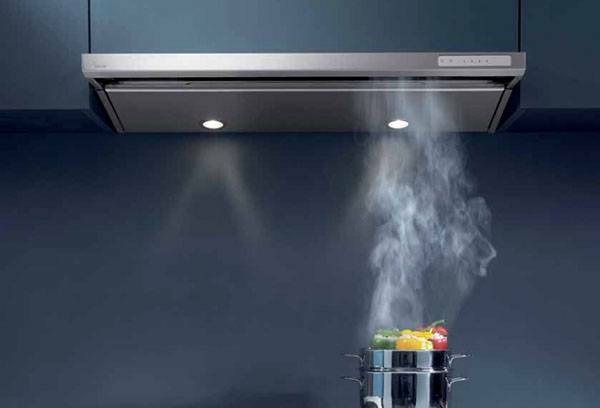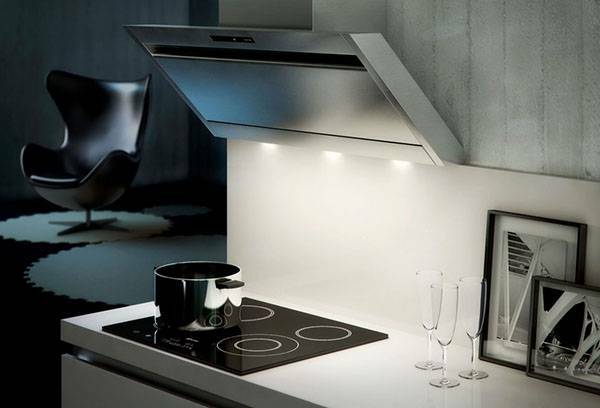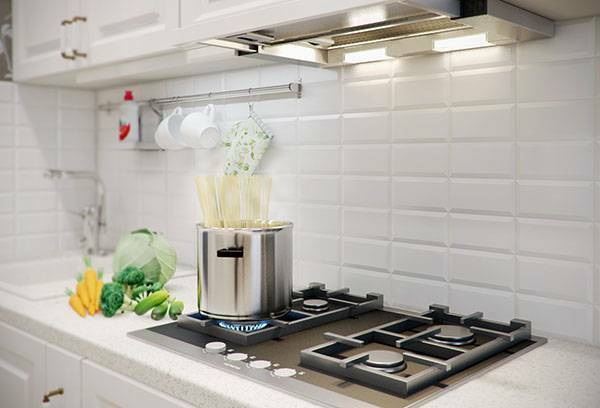Contents:
Contents:
How to use
To avoid unpleasant odors in the kitchen, you need to put the hood on it. But there may be limitations imposed by the design features of the room. In particular, it is not always possible to place a classic hood, because not everywhere there is an air duct or it can be easily equiped. But this is not a problem - the solution will be a hood for the kitchen without an air duct. We'll figure out what it's like, how to choose it correctly and what kind of devices of this type there are.

How it works
The hoods that operate the air duct are flowing. Their essence lies in the fact that they tighten the air from the room - and throw it into the common ventilation duct. The air is renewed by means of loosely closed windows facing the street. This is a fairly effective option for cleaning the room, because the polluted air is completely removed from the room, replaced by a new one. But the restriction is the presence of an air duct - the ventilation system of the house as a whole or a separate outlet to the outside.
How does the hood work without a duct? Such electrical equipment is usually arranged according to the principle of recirculation systems. In other words, the devices draw contaminated air into a special tank. There it is thoroughly cleaned, passes through special filters, after which, already in its pure form, again enters the room.
Circulation hoods for kitchens without ducts filter the air in two stages. On the first, sufficiently large particles of soot and carbon deposits are eliminated. On the second, a more serious cleaning is carried out, in which the smaller particles are removed, which are responsible for the appearance of unpleasant odors in the room. There are also combined models that can work in both modes.

More about
filters In total, up to 4 filter elements are usually found in the hood. The first level filter is fat-absorbing. It can be made of metal( usually aluminum, due to its lightness and cheapness), acrylic sheet or paper( less often - non-woven and sintepon).The first two options are designed for reusable use, the latter - disposable, they should be changed when they completely stop being visible due to the accumulated pollution of a special indicator.
Council
Replace or clean the filter should not only for reasons of air purity, but also by fire safety rules. The abundant accumulation of fats and soot on its surface with accidental sparks or strong heating can ignite.
The filters of the second level, which purify the air of unpleasant odors, contain activated charcoal with various additives. Their service life depends on the model, intensity of use and other factors, but on average they are changed not more often 3-4 times per year( a little less often than water filters).

Advantages of
The hood for kitchen without duct has the following advantages:
- does not interfere with the natural air exchange of the room;
- easy installation - no need to connect to the duct, just connect to the electrical network and fixing in furniture or on the wall;
- lightness of construction;
- compactness, which is especially valuable in conditions, as a rule, small kitchens in Russian homes;
- easy care;
- is suitable for kitchens of any size and configuration;
- independent work( there will not be, for example, problems with a clogged ventilation duct);
- low price of both the device itself and its installation.
But there are also no shortcomings:
- requires frequent replacement of filters( and costs for them, respectively);
- smaller choice of models( applies not so much to the technical variety of devices as to the options for their design design);
- somewhat worse degree of air purification;
- absence of any influence on the humidity in the room.

Versions of
The most common types of hoods for a kitchen without a duct are as follows.
- Flat exhaust hood. It is based on the body panel, filters and a fan that draws air. We can distinguish both vertical and horizontal extracts of a flat type.
- Built in hood. Its design is similar, but it is closed by a hanging cabinet or panel, so as not to attract attention.
- Telescopic hood. A variation of the built-in, the difference is that if there is a need in it, you need not open the panel, but push the hood itself.
Circulation hoods for kitchens without air ducts may also differ in the material from which they are made. Usually, glass or chrome-plated aluminum is used.
As for the functional, simple models are equipped with a mechanical control and a minimum of possible settings. The more expensive ones are equipped with convenient touch screens and remote controls, and the possibilities of the technique are much wider: clocks, timers, temperature and humidity sensors, periodic automatic switching on and off, filter contamination indicators, different intensity of air purification, etc.

Selection principles
To choose the right hood for the kitchen, you need to pay attention to a number of factors:
- Design. It is important, because the hood should be combined with the interior. The choice of models without a duct is small, because the market can not find so many design solutions. In extreme cases, you can always give preference to a minimalist, laconic design, which will be neutral enough to be combined with any interior.
- Size. First, the hood model should be placed in the kitchen and not interfere with other pieces of furniture. Secondly, it should be understood that the more the working surface of the equipment, the more effective the cleaning will be. The length and width of this surface are determined by the size of the slab and the dimensions of the kitchen, but the height relative to the slab should be at least 65 cm for electric and 75 for gas.
- Noise level ( this indicator directly depends on the power and dimensions of the device, so do not go into a small kitchenette to buy a very productive and huge unit).Normal is considered if the hood is not noisier than 40-45 dB.
- Performance. For the optimum level of cleaning, the whole volume of kitchen air must pass through the hood 6-12 times per hour. Calculate the minimum required power easily - the volume of the room( the product of height, width and length) is multiplied by 6. For example, a room with a capacity of 25 cubic meters will require an extraction capacity of at least 150 m3 / 60 minutes.
- The range of settings, which directly affects the ease and convenience of using the device.
- Availability and price of consumables ( once saving on technology, you can then repeatedly overpay for expensive or rarely available commercially available replacement filters).
- The cost of ( for simple devices it starts from 3-4 thousand rubles, for a fairly powerful, productive and flexibly adjustable hood for a kitchen without an air duct, the price is already in the range of 10-20 thousand rubles).
Having picked up several optimal models of different manufacturers, it will not hurt to read reviews about them - this will help determine the choice and avoid problems with poor-quality goods.

Drawing care
The most important component of the care of the extraction equipment is the timely replacement of the filter. A number of models are equipped with indicators that indicate the need to change the filter elements. If they do not exist, it's time to change filters, it will remind the deteriorated quality of air purification in the room.
If the hood to the kitchen without a duct is equipped with a paper or non-woven rough filter, it is simply changed to a new one, since it is designed for single use. Acrylic or metal filters can be cleaned from soiling by washing in a dishwasher or manually in soapy water, dried and reused. Coal scavengers of odors also need replacing, the second round they will not be applied.
Advice
Do not wash the filter in the dishwasher together with dirty dishes - particles of dirt and grease from it can clog the filter holes, thereby spoiling it.
The body of the device itself should be regularly cleaned of accumulated contaminants, using detergents suitable for the material of its surface. On this, in fact, everything - with these simple rules, the extractor will serve in the kitchen for many years.

Summing up
Extracts without ducts, working on recirculation principle, it is a convenient and practical solution for almost any kitchen, whether it is huge and luxuriously decorated, or very tiny and having a minimalistic and exceptionally practical design. With the timely replacement of filter elements and the correct selection of performance, this technique fully ensures the cleaning of the air in the room, easy both in the installation and in the subsequent care. If you still have any doubts, it is worth paying attention to universal combined devices that can work in the mode of recirculation or air extraction into the ventilation system.
